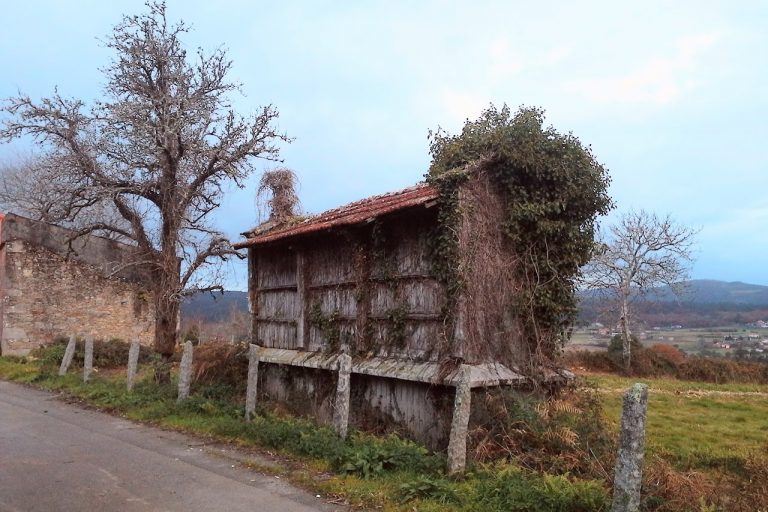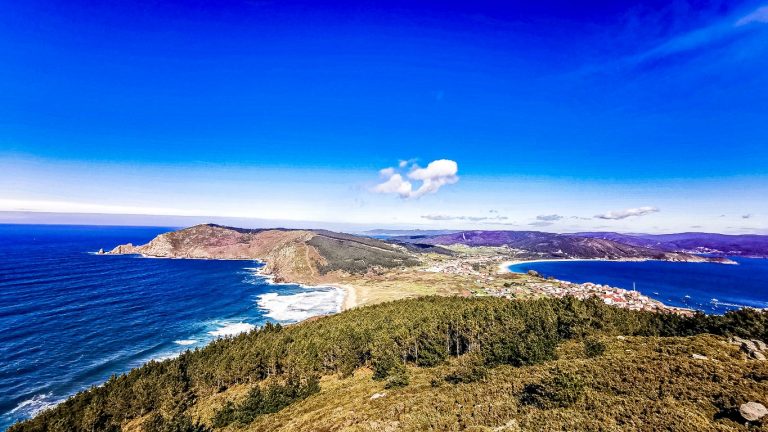

A New Stage Day – Beginning & Atmosphere
In Estella, the “Beautiful One,” a new day begins. You leave the city along narrow streets steeped in history, and soon after you reach one of the most famous landmarks of the entire Camino: the Fountain of Wine in Irache. Here, at the medieval monastery, pilgrims can choose between water and red wine, which flows from a tap into the shell. A place where spirituality and sensuality are uniquely intertwined – and where many pilgrims pause for a moment to feel the spirit of the Way.
The day itself proves more demanding than the mere kilometers might suggest. Constant ups and downs, small climbs and descents, a “rompe-piernas” – a leg-breaker – requiring more patience than strength. Yet the rewards are landscapes, places full of symbolism, and finally the arrival in Los Arcos, where the magnificent church of Santa María marks the destination.

Route & Elevation Profile
- Distance main route: 21.6 km
- Elevation gain: +482 m / –457 m
- Variant via Luquin: 20.9 km, +514 m / –488 m
- Difficulty: easy–moderate
The route is less demanding due to extreme climbs than because of the constant ups and downs. The most notable ascent leads to Villamayor de Monjardín, where a Romanesque gem and wide views await. The last part between Villamayor and Los Arcos stretches over many kilometers with no supply points.
Description of the Way – With All the Senses
Beyond Estella and Ayegui the Camino leads you to the monastery of Irache. Its stone walls tell of centuries of monastic life, and right beside it bubbles the famous Fuente del Vino. A symbol of the generosity of the land, but also a reminder to walk with moderation and mindfulness.
Shortly afterwards you pass through Azqueta, a small village that embodies the charm of Navarra with narrow streets and houses of light stone. From here the path climbs, soon forcing pilgrims into the rhythm of the day: up and down, again and again. The notable ascent to Villamayor de Monjardín takes you up a hill where one of the Camino’s most impressive Romanesque churches awaits: San Andrés, simple, powerful, and with an atmosphere that invites you to linger. From up here the landscape opens wide, fields and vineyards stretching to the horizon.
After Villamayor follows a long section that demands patience: kilometer after kilometer across open fields, little shade, no villages, no bars. Especially on hot days this path becomes a trial. Yet it is here that one of the truths of the Camino lies: the experience that endurance and inner calm sustain you when there is little outward distraction. Finally, in the distance the goal rises: Los Arcos. A place whose heart is the church of Santa María, plain on the outside but with a baroque interior of overwhelming splendor. Whoever enters feels the contrast between the simplicity of the Way and the opulence of art.

The Variant via Luquin
Not all pilgrims choose the main route via Villamayor. An alternative leads through Luquin. At just under 21 kilometers it is slightly shorter but requires a bit more elevation gain. Luquin itself is a quiet village, far from the classic pilgrim flows. Those who take this path exchange the Romanesque church of Villamayor for the silent beauty of a lesser-known village. The path leads through similar landscapes, vineyards and fields, and above all grants the feeling of having the Camino almost entirely to oneself for a stretch. For some it is a welcome change, for others a sacrifice of the historical treasures of the main route.
Intermediate Places & Special Features
| Place | Distance from Estella | Feature |
| Ayegui | ca. 1.8 km | First services, hostel San Cipriano |
| Monasterio de Irache | ca. 2.6 km | Monastery, famous wine fountain |
| Azqueta | ca. 7.6 km | Small village |
| Villamayor de Monjardín | ca. 9.6 km | Ascent, Romanesque church San Andrés |
| Luquin (Variant) | +1.8 km detour | Alternative route, less frequented |
| Open field section | 10 km without villages | No services, lots of sun → water essential! |
| Los Arcos | 21.8 km | Church of Santa María with splendid baroque interior |

Food, Lodging & Supplies
- Estella / Ayegui: wide selection of hostels, hotels, supermarkets.
- Irache: monastery visit, wine fountain.
- Azqueta: bars, small accommodation options.
- Villamayor de Monjardín: several albergues, dining options.
- Between Villamayor and Los Arcos: no services → absolutely bring water!
- Los Arcos: numerous hostels and private accommodations, including the large pilgrim hostel “Isaac Santiago” and charming small hostels.
The Special Today
The day is marked by symbols: the Fountain of Wine, the Romanesque church in Villamayor, the long section without distraction, and finally the baroque splendor of Los Arcos. It is a stage that both challenges and richly rewards: physically through the ups and downs, spiritually through the quiet moments in the fields, culturally through places steeped in history.
Reflection at the End of the Stage
Today you learned what “rompe-piernas” means: not a great pass, no extreme climbs, but the constant ups and downs that shape the Camino in Navarra. You paused at the Fountain of Wine, walked through villages that have welcomed pilgrims for centuries, and finally arrived in Los Arcos – a place whose church interior comes as a surprise. A stage that teaches patience and endurance, and that rewards with beauty.
📊 Tabular Overview
| Stage | Start | Destination | Distance | Elevation | Difficulty | Intermediate Places |
| 6 | Estella | Los Arcos | 21.8 km | +482 m / –457 m | easy–moderate | Ayegui, Irache, Azqueta, Villamayor de Monjardín (or variant via Luquin) |
🌌 Camino of the Stars – Stage 6
Estella → Ayegui → Irache → Azqueta → Villamayor de Monjardín (→ Luquin, variant) → Fields → Los Arcos
Call to Action


